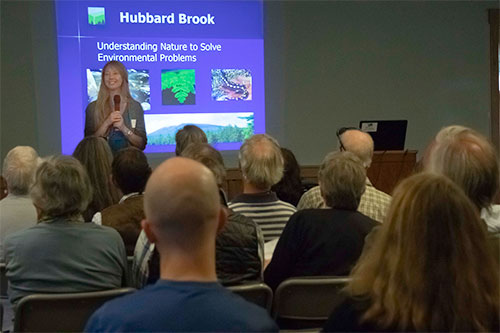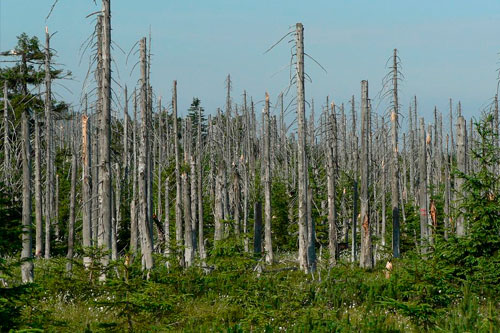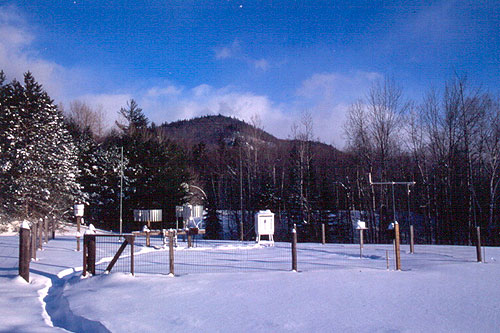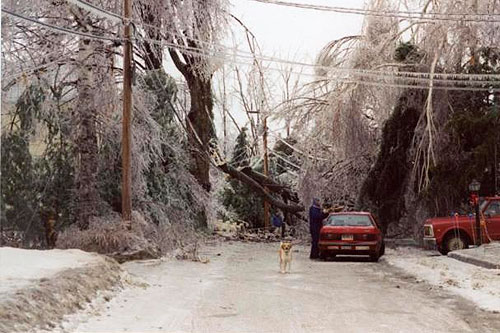Walking the Tightrope: Exploring the Delicate Balance of Ecosystem Science, Public Policy and Land Trusts

The boundary between science and politics is precarious. The integrity of scientific research is based on an assumption of neutrality: observe, document and report data on subject areas. Scientists can be reluctant to introduce their research into policy debates for a legitimate reason: they risk being charged with predetermined conclusions driven by political bias.
But what if their studies can provide a foundation for reversal of environmental damage, and even better, inform public policy that will prevent further destruction? This is the tightrope that environmental scientists walk, including those at the Hubbard Brook Experimental Forest (HBEF).
The HBEF, a 7,800-acre northern hardwood forest situated in the White Mountains of New Hampshire, is the location of one of the longest running and most comprehensive ecosystem studies in the world. It is a unique public-private partnership involving the USDA Forest Service, the National Science Foundation’s Long Term Ecological Research program, the Hubbard Brook Research Foundation, and scientists from research institutions throughout the country. The collaborative, multidisciplinary research efforts include long-term studies of air, water, soils, plants, and animals.
Five Rivers Conservation Trust was privileged to have Anthea Lavallee, Executive Director of the Hubbard Brook Research Foundation, as the featured speaker at our 2019 Annual Gathering. In her audience-interactive presentation, Lavallee introduced us to the broad range of watershed studies that have been conducted at the HBEF since its beginning in 1955, leaving us with a deep appreciation for the intersection of environmental policy, practice, and ecosystem science. Two examples are worth noting.
Example 1
In the early 1980s, alarm bells were ringing across the Northeast. From New York’s Adirondack Park, to Vermont’s Green Mountain National Forest, New Hampshire’s White Mountain National Forest and Baxter State Park in Maine, alpine forests were dying, sugar maples were declining, and fish were disappearing from lakes. The chemistry of entire watersheds was experiencing radical change. What was going on?
It turned out that most of us were just slow on the uptake. Lavallee explained that these were symptoms of a phenomenon that had been recognized in the 1960s by a team of scientists who founded the Hubbard Brook Ecosystem Study (HBES), a collaborative approach between academic research and the U.S. Forest Service. From the study’s inception, rain and snow inputs to the HBEF were unusually acid. These scientists had identified what would soon become a household word: acid rain.
But documenting unusual ecosystem acidity begged several questions: what was causing it? Was it a problem? If so, was it reversible and ultimately preventable? The team set out to probe deeper into the implications of ecosystem acidity.
Ultimately, the primary source of the pollution was traced to the combustion of fossil fuels at manufacturing hubs hundreds of miles away in the Midwest.
Enter a coalition of environmental groups including the Appalachian Mountain Club and The Society for the Protection of NH Forests, who approached members of the congressional delegations from the most threatened states, including former US Senators Judd Gregg (NH), Robert Stafford and Jim Jeffords (VT), and Olympia Snowe (ME). The Hubbard Brook team, duly alarmed by the conclusions of their studies, provided the legislators and environmental lobbyists with indisputable scientific data that justified amending the Clean Air Act to limit pollution at the stack, initiating new technology such as “clean coal” and “stack scrubbers”.
Was the risk of leaping the chasm between pure science and politics worth it for the Hubbard Brook scientists? Indeed. As Lavallee noted, continued ecosystem monitoring has shown that it paid off handsomely for the Northeast.
Over a period of eighteen years subsequent to the newly enacted federal regulations to reduce SO2 emissions, the HBEF team documented about an 80% decline in acidity at HBEF. This reinforced the value of continuous long-term scientific measurements and data collection, and demonstrated the critical role of ecosystem science in development of effective environmental policy.
But there was more to the story. What about the havoc acidification had wreaked on the natural and built environment? In addition to identifying the cause of acid deposition, the HB studies suggested that not only could further damage be prevented, but existing damage could be reversed by restoring the natural (preindustrial) ecosystem chemistry that acid deposition had altered. The Hubbard Brook data had identified a correlation between acid deposition and leaching of the natural levels of calcium in the affected ecosystem. In 1999, wollastonite (a calcium silicate mineral) was added experimentally to an entire watershed in an amount roughly equivalent to the quantity estimated to have leached in the previous 50 years. When calcium was replaced, the forest showed accelerated levels of recovery, such as positive survival and growth responses in sugar maples. Lavallee concludes that through science, there are solutions, emphasizing its role in protecting the air we breathe and water we drink every day.
Example 2
On a frigid January night about two decades ago, many of us woke to what sounded like random gunshots in our neighborhoods. Far from it. A look out the window showed that we were in the midst of what came to be known as The Great Ice Storm of 1998 and tree limbs were cracking like toothpicks under the weight of a heavy coating of ice. It caused unprecedented damage to trees and electrical infrastructure all over the area, leading to widespread long-term power outages. Millions were left in the dark for periods varying from days to several weeks, and in some instances, months. It led to 35 fatalities, a shutdown of activities in major cities such as Montreal and Ottawa, and an unprecedented effort in reconstruction of the power grid. In Canada, the ice storm led to the largest deployment of military personnel since the Korean War. In the US, it took months for power companies and state and municipal workers to clean up the damage and fully restore power to thousands of residents.
Such extreme weather events cannot be prevented, but what if we were able to predict their impacts in order to prepare for them effectively? Lavallee explained how the ecosystem scientists at HB approached the problem.
Ice storms are an important natural disturbance in the forest ecosystems of the “ice belt” that covers a broad area extending from east Texas to New England. These glazing events (defined as 0.25 in. of ice accretion or more) are often perceived as rare occurrences, even though the return interval is as short as 2-5 years in the most ice storm prone northeastern U.S. Historically, ice storms have been hard for meteorologists to predict, and despite their influential role in shaping forest ecosystems and the services they provide, knowledge of their impacts on the natural and built environment has been relatively limited.

Photo by Joe Klementovich
In 2016 and 2017, to shed light on these poorly understood weather events, HBEF conducted the first-ever controlled, experimental ice storm manipulation in a forest ecosystem. Using a suite of tools to create artificial ice storms, water was pumped out of Hubbard Brook and sprayed over the forest canopy during subfreezing conditions to simulate a glaze ice event. The falling water froze on contact, resulting in 0.4 in. of ice accumulation, which is comparable to measurements at Hubbard Brook during the major ice storm of 1998. Through this experiment, researchers could see when and where damage started to happen (between 1/4 and 1/2 inch of ice accretion), and followup continues to document the rate of forests and wildlife recovery. The data have also provided predictive models for the effects on the power infrastructure, the most effective tree pruning techniques around power lines, and how to best mobilize personnel and equipment to prepare for and respond to storms. Results of this research will provide land and emergency managers and the concerned public greater insight on the impacts of these powerful, frightening, and curiously aesthetic extreme winter weather events on ecosystem dynamics in northern hardwood forests.
What can a land trust learn from the HBEF?
Lavallee encourages what she calls “building a culture of everyday inquiry.” In other words, you don’t have to be a credentialed scientist to contribute to have a scientific appreciation of the landscape. In a very real sense, the collective conserved acreage in the Five Rivers service area – though largely non-contiguous – is similar to the giant petrie dish of HBEF. Just as the scientific community is monitoring the Hubbard Brook watershed, we have the potential to contribute to a database for ecosystem changes as we monitor our conserved landscape. Operating within a dynamic natural system, our monitors could combine a love of the land with a scientific understanding of it, which can ultimately reinforce its protection. For example, easement monitors tend to be people who appreciate the multiple attributes of a landscape. In addition to the traditional checklist of changes to a property that monitors are required to document to maintain the legal requirements of the easement, they could record observations of bird and animal populations, the occurrence of plant species, and changes in growth patterns. Or, Five Rivers could initiate a new volunteer team of “citizen scientists” to accompany the existing easement monitors.
When asked about the immediate priorities for Hubbard Brook, Lavallee identifies climate change as a huge research thrust which could benefit from such local data collection. For example, Hubbard Brook could provide us with simple monitoring protocols to identify how much carbon a parcel of land contains which in turn identifies an added value to the land. Various ecosystem services can be targeted and managed, beyond, for example, timber or agricultural production. These include drinking water filtration, flood abatement, carbon sequestration, erosion mitigation from catastrophic weather events, wildlife habitat preservation, and other climate change resilience attributes.
And all this from a little experimental forest in NH. Who knew? Five Rivers is grateful to Anthea Lavallee for her fascinating and thought provoking presentation at Annual Gathering. Anthea expressed how much she enjoyed speaking to us, through her presentation but also informal mingling before and after the program. A great conversationalist, she is eager to share information and available at The Hubbard Brook Research Foundation, alavallee@hubbardbrookfoundation.org or (802) 432-1042. Visit the Hubbard Brook website: hubbardbrook.org
Visiting Hubbard Brook
Can people visit Hubbard Brook? Absolutely. We are fortunate to have Sarah Thorne as a Five Rivers board member, who is also on staff as an educator at Hubbard Brook and enthusiastic about taking interested people on a tour. Hubbard Brook is public land, and there is even an App for a self-guided tour.







